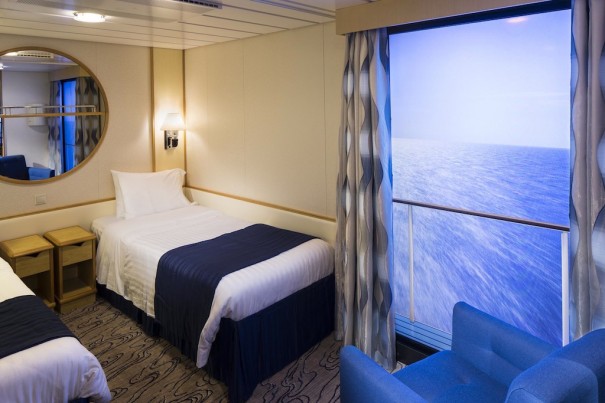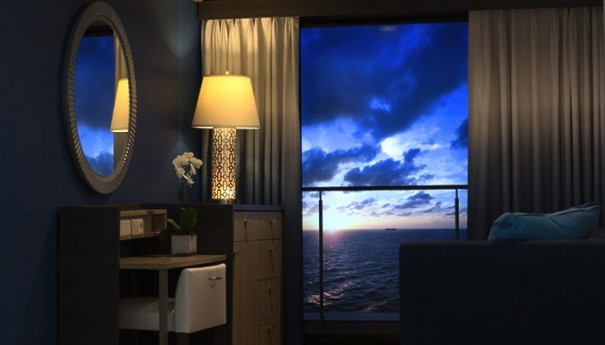Virtual balconies of 80 " and HD in interior cabins to enjoy the cruise in real time
Recreating the navigation of a cruise in real time and the different times of the day in an indoor cabin is the innovative bet of the cruise company Royal Caribbean, that has installed virtual balconies with 80" HD screens and Control Group technology to improve the comfort of its customers during the journey in real time.
The cruise company Royal Caribbean has decided to improve the quality of customers traveling in an indoor cabin with an innovative solution: virtual balconies composed of screens of 80 inches in high definition developed by the North American company Control Group that simulate with the utmost realism the exterior during the crossing.
This initiative starts, according to those responsible for Royal Caribbean, of "listening to our Crown partners & Anchor Society and we made the changes they asked us to make, offering an alternative for passengers who do not wish to pay more for a stateroom with balcony, harder to come by". From this month of February, the company has started installing these virtual balconies in 81 interior staterooms of the Navigator of the Seas, one of the ships of its American line that has just been remodeled.
Audiovisual and physical challenge
The concept and design of these virtual balconies is based on 80" high definition screens framed and with a railing to simulate a true balcony, extending from floor to ceiling of the stateroom, and showing what's going on outside the ship in real time, so that passengers who do not have an outdoor balcony can also enjoy the scenery in their interior cabin, even in those who do not have aney eye.
As Charlie Miller explains, of Control Group, "We made a virtual balcony with a framed HD screen, with a railing with simulated security balustrade and strategically placed with its curtains to recreate to the maximum a real balcony. But this went far beyond a camera projected onto a real-time screen., since it incorporates an innovative fiber communication system to avoid delays in the retransmission of the video".
 While the concept of virtual balcony seems at first something very simple, as Miller recalls, "the technological work has been tremendous, with challenges everywhere that had to be overcome to offer an experience as human and authentic as possible".
While the concept of virtual balcony seems at first something very simple, as Miller recalls, "the technological work has been tremendous, with challenges everywhere that had to be overcome to offer an experience as human and authentic as possible".
In this sense, Royal Caribbean previously tested a Control Group virtual balcony with about thirty people at its corporate headquarters, whose common denominator was that "a view of the open sea is a little scary," miller recalls., especially when the ship is moving on the high seas, so the virtual railing was necessary. Taking into account, evidently, that no one can fall through a wall, even if this is a screen".
One of the challenges was that the virtual railing had to look like it was outside the window., just like in a real situation, "and that the different changes of light and the ship were reflected, which created a new set of visual challenges", Underlines.
To overcome this challenge, the technicians decided to incorporate graphics of the movement of the sun, as well as powerful GPS data to add 'real' shadows and virtual railing highlights. At the same time, it was decided not to put virtual glass between the balustrades to provide greater realism and that the image of the ocean occupied it. "
New challenge: the movement of the sea
If the previous problem was relatively easy to solve, the real challenge was to reproduce the movement of the ocean. That's why, the technical managers Control Group decided to consult with experts from MIT and Harvard, "as we had to answer the questions around how people would react to an immersive screen in a small place without sunlight. Two scientists from MIT and Harvard advised us on the design of mechanisms that would offer the best image but avoid the unpleasant side effects that occur when visual perceptions of movement are not coordinated with real physical sensations., details Miller.
 This meant that there had to be minimal delay between the power of the camera and the virtual balcony screen.. "The solution was an advanced and rare Fibre Channel technology that we were advised to incorporate. Once we got to a latency of less than a second it wasn't a problem anymore.", miller points out.
This meant that there had to be minimal delay between the power of the camera and the virtual balcony screen.. "The solution was an advanced and rare Fibre Channel technology that we were advised to incorporate. Once we got to a latency of less than a second it wasn't a problem anymore.", miller points out.
One of the fundamental elements of all this technology has been, as this person in charge points out, incorporate the award-winning RED Epic high-definition cinema camera to capture the images that guests would see on screens, "We installed one on the bow and one on the stern of the ship. It was decided that the best viewing angles were not on the sides of the ship, but back and forth. In fact, staterooms that have real balconies have these same views, so each virtual balcony has been placed on a side wall and not the port or starboard wall".
In addition, to this challenge was added that all this technological gear had to withstand the marine weather of salt and water, the sun and heat, the wind,... "We have overcome all the atmospheric conditions," miller confirms.. Fiber optic cable takes video to a server, below, to a decoder that decodes and processes the video before it appears on the screen, but the real triumph is that there is no latency between the camera and the screen".
Images and audio
The designers chose to incorporate into each room with a virtual balcony a remote control so that guests had the possibility to choose to view the images of the same or not, as well as control the volume of audio that is received from outdoor cameras, although they cannot change the fore and aft views offered by the front and back cameras.
 In this respect, Ronnie Farzad, of royal caribbean's technology and entertainment department, points out that "this decision responds to the coordination of visual images with physical sensations. At first we hadn't even thought about it., but it was necessary to avoid guests walking in the wrong direction and avoid an annoying feeling".
In this respect, Ronnie Farzad, of royal caribbean's technology and entertainment department, points out that "this decision responds to the coordination of visual images with physical sensations. At first we hadn't even thought about it., but it was necessary to avoid guests walking in the wrong direction and avoid an annoying feeling".
Another technical decision was to use a wide angle, a 'fisheye' lens on cameras, "since they offer us a much more accurate representation of the images, as if seen from a real balcony, in addition to drastically reducing the sensation of movement in the image. The only thing missing from these balconies, Of course, it's the fresh air of the sea breeze".
The company is also installing smaller versions of the virtual balconies in the 'studio' staterooms for a single person.
Royal Caribbean no es la primera línea de cruceros en ofrecer una vista virtual en sus buques, although yes with this advanced technology. The Disney cruise ship fleet pioneered offering virtual portholes in their interior cabins, with circular screens of 42 inches showing a video channel with images from a live camera installed at the stern of the ship.
You liked this article?
Subscribe to our RSS feed And you won't miss anything.
• section: Case studies, outstanding, HIGHLIGHTED Case Study, Digital signage, display, Signal distribution, business, simulation





